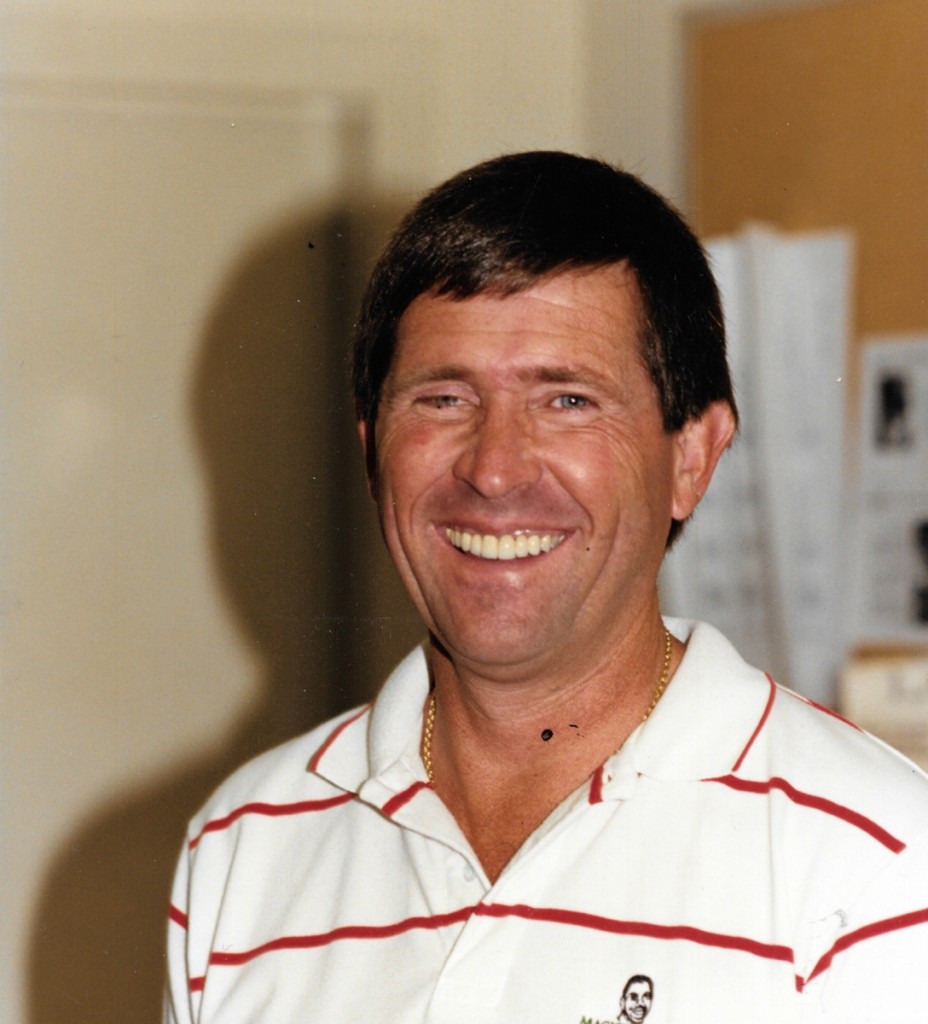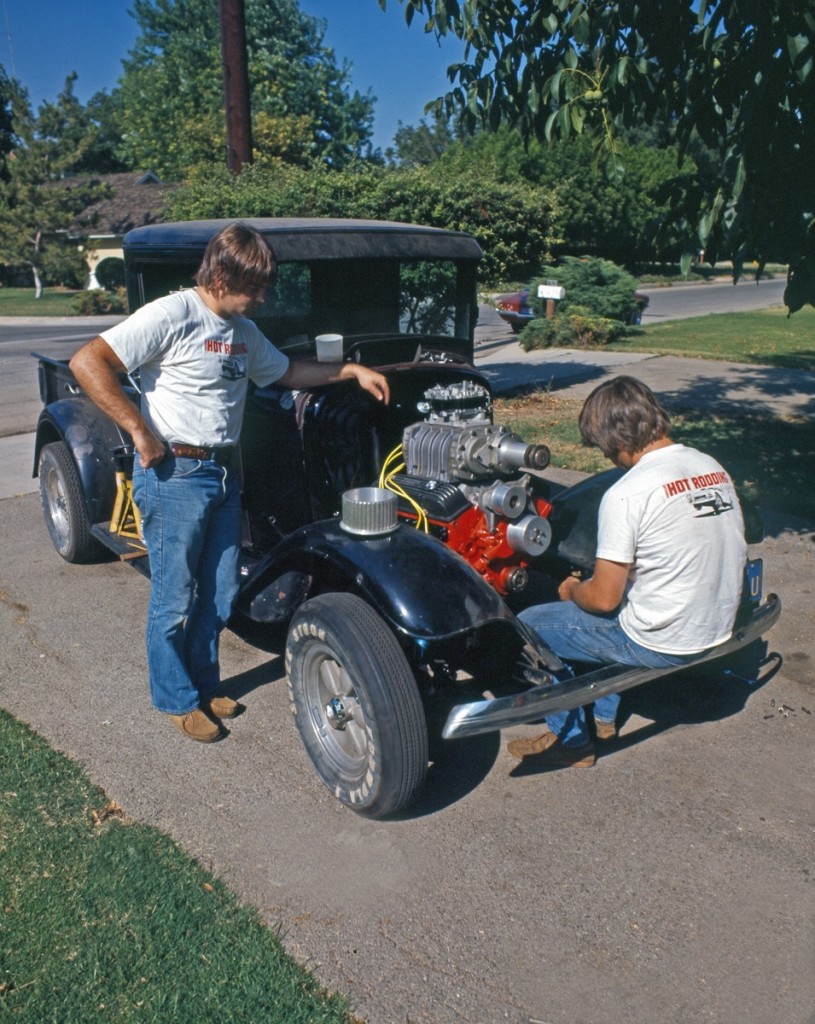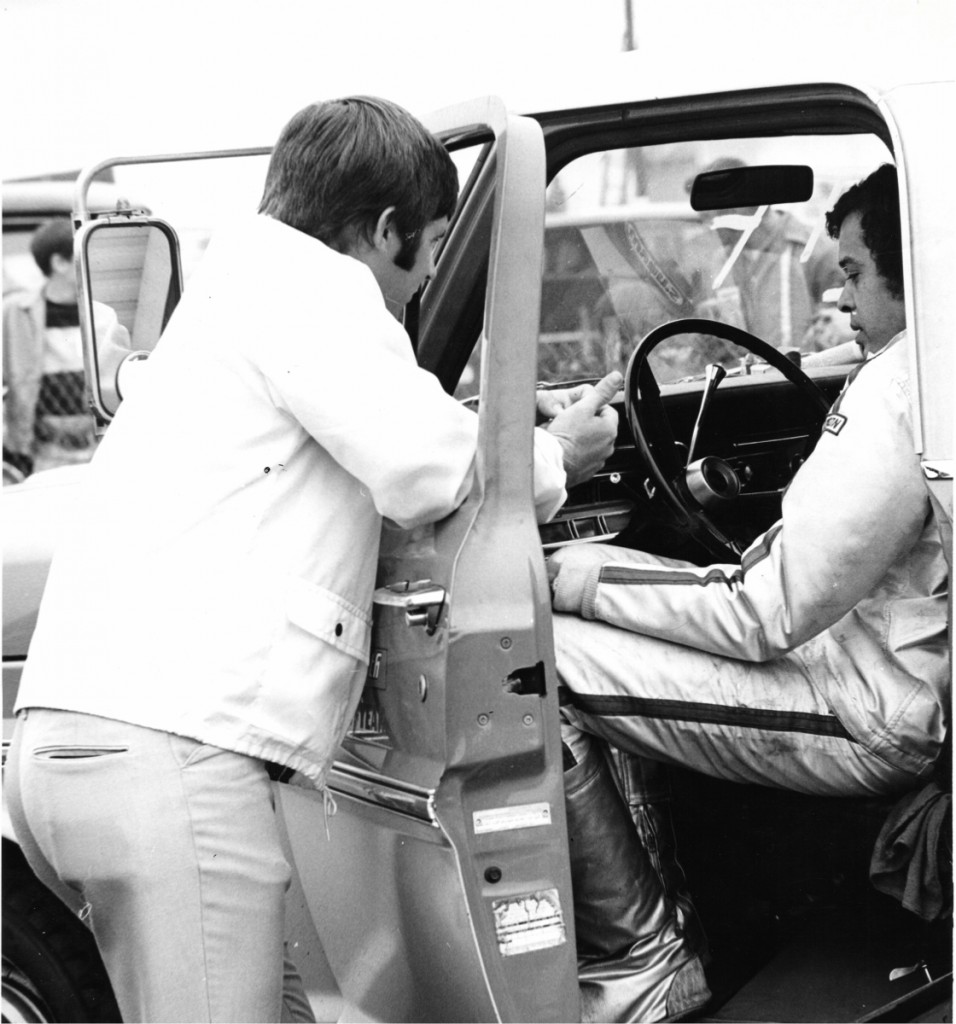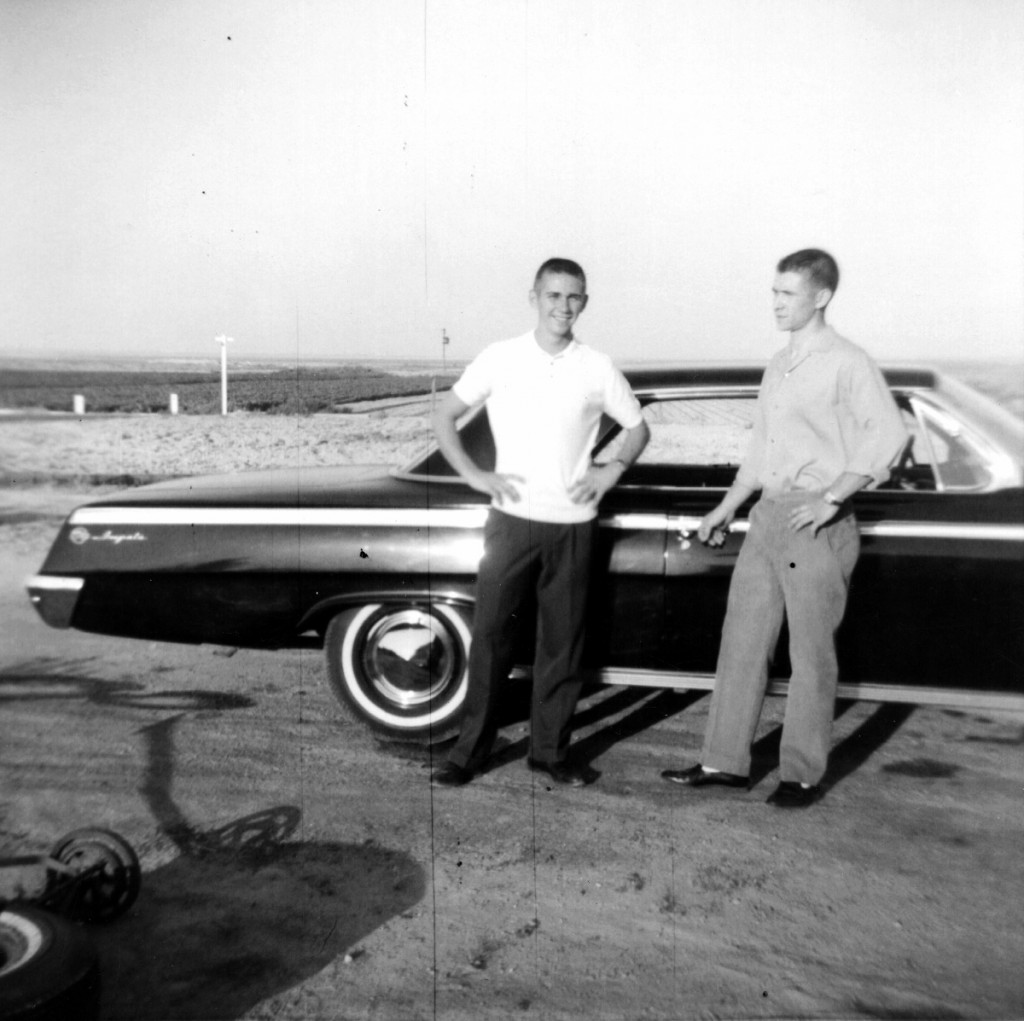Lee Kelley’s 40+ years of car building, racing and content creation helped shape the automotive enthusiast landscape forever
Words: Cam Benty; Photos: Lee Kelley and Steve Reyes

Lee Kelley hung with the right crowd, if you were into cars back in the early 1960s. This photo, from the National Rod Run in Benton Harbor, Michigan, includes several Argus Publishing staff members including Ed Obrien, Jay Amestoy, Kelley, and Tom Madigan.
It’s strange the things that motivate people to find their individual career paths. For Lee Kelley, his love of cars played a huge part in his selection of employment. As a first-year college student, it was the passion to purchase a ’62 409c.i./409-hp Chevy that took him from the classroom to full-time work for Standard Oil. But, it was an ad in Drag News weekly newspaper for a writer/photographer that was to change his life forever.
Kelley spent most of his car building days in Taft, California, having moved west after his early upbringing in the town of Gran-bury, Texas, 30 miles outside of Ft. Worth. In the early to mid-1960s, racing in California was never hotter, with racetracks blanketing the southern California landscape. An avid car enthusiast and racer at the age of 25, Kelley constantly scrutinized his 409 Chevy to improve its performance — often enlisting ideas he read about in the enthusiast magazines.
As mentioned, it was an ad in a March 1967 issue of Drag News, one of the biggest drag racing publications at the time, that an undisclosed publication was looking for a writer and photographer. Kelley, figuring he had the writing part down and could learn how to take photos, sent his resumè in for the job. It turned out to be a position with Argus Publishers and Popular Hot Rodding magazine (PHR). Within a couple of days of sending his letter, he was in the Los Angeles office of magazine editor Jack Scagnetti interviewing for the job — all the while figuring his chances of getting the job were plenty slim.

A classic driveway scene, Lee Kelley, left, with long time friend Lenny Emanuelson, who was to follow Lee as editor of Hot Rod in 1981. This ’32 Ford truck was well known to hot rodders back in the day.
As would be the case, he did not get the job, that position falling to another well known writer of the era, Forrest Bond. But evidently, Kelley made an impact on Scagnetti, for it was not more than a month later he got the call to come on staff at PHR. In the mid-1960s, the cars were never cooler and the racing never hotter. Moving from rural Taft to Los Angeles would seem to have been a major step, but surrounded by the cream of the automotive elite, the transfer for Kelley was not an issue.
It was not long after Kelley’s landing at PHR that Jack Scagnetti left the company, Kelley working directly with George Elliott, who had taken over the editorship of the magazine. Elliott was extremely pleased to have the help, and Kelley would soon learn this was an 80-100 hour a week job between writing, shooting photographs, and visiting racetracks and shops to find content for the magazine. For a real car guy like Kelley, it was literally more of a “kid in a candy store” type of problem — which was no problem at all.
“I would spend 20 to 30 hours a month over at Ak Miller’s Shop in Pico Rivera developing tech stories about engines he had under way and cool cars that were owned by the customers that came to Miller’s,” Kelley says. “I would do as many stories as I possibly could to fill the magazine since it was really just George and myself building both PHR and other specialty magazines. In a month’s time, I’m certain that we each produced a full magazine’s worth of articles [60 pages of content].”
Just when he thought this was the coolest job ever, Kelley was introduced to yet another source of car entertainment — the auto-motive manufacturer “Long Lead” presentations. Due to the length of time between when the magazine was produced, printed, and actually delivered to the readership, the new car manufacturers would show automotive journalists the new cars and trucks, three months prior to the launch to the public. In addition to receiving a trip to Detroit to see the new cars and talk with the engineers that produced the cars, it meant a chance to drive the vehicles flat out on the private manufacturer test tracks. For Kelley, his first assignment was the Long Lead introduction of the 1968 Buick Grand Sports.
“It was more than I could have hoped for,” Kelley says. “They had all the hottest Buicks at the time, and they even had a driving competition that I remember well.”
It’s where Kelley first met Ray Brock, then publisher of Hot Rod magazine. That chance meeting with Brock developed into a last-ing friendship. In August 1967, Kelley covered Bonneville for the first time and spent some “salt time” with Brock.
When they parted at Bonneville, Brock punctuated their visit with the comment, “if you ever want to work for a real magazine, you should think about Hot Rod.” The result of those encounters would be a job offer only nine months into Kelley’s employment at PHR. Less than a year into his journalistic career, he was on staff at Hot Rod magazine.
“When I went to Hot Rod, it was very different from PHR,” says Kelley. “At PHR we had to crank out lots of content. I really enjoyed that frankly. Elliott and I were always at the drag strip testing products and going to shops.”
“When I went to Hot Rod, all that changed. Instead of having the opportunity to really do any story I felt had merit, at Hot Rod I had to fight to get my one or two stories into an issue,” Kelley continues. “They had a staff of six or seven writers, and they all had their areas of expertise. After about six months, I decided that PHR was a better fit for me and went back to working with Elliott.”
Project X and life at Argus Publishing
Starting in 1968 and continuing for the next nine years, Kelley built a reputation for PHR and himself as an alternative for Hot Rod and the Petersen Publishing magazines. Elliott introduced Project X in 1966, the ’57 Chevy that still lives on today as an iconic vehicle. At the same time, Kelley had a really cool, five-window ’32 Ford with a Pontiac Ram Air IV engine that he’d race and test. In addition, he began building a ’33 Ford pickup, since in order to do a lot of the product testing for articles, you needed plenty of raw material.
It was Project X that really kicked things up in a big way, the ragged ’57 taking on Elliott’s vision for a highly popular platform that served to show the performance improvements possible with available parts. His personal dedication to working and racing the car on the weekend and writing about it back at the office with Kelley was a regular cycle. Every issue of PHR had multiple pages dedicated to Project X’s latest racing and street performance alterations. The car became a celebrity among automotive enthusiasts.
“We swapped out and tested engines, transmission, rear ends, and suspension parts and wrote about the results of these changes in every issue,” says Kelley. “We even tested gasser-style fuel injection, intake manifolds, headers, and all kinds of new hot rod parts. If it was new, it went on Project X.”
Project X got quicker and quicker. Starting with mid-15-second time slips when stock, things improved and readers took note. Racing at legendary southern California tracks like Lions, San Fernando, Irwindale, and Orange County, the story of “X” reads like a history of racing. At the same time, Elliott’s driving skills were tested, and he shone brightly. After some significant tuning, Kelley re-members Project X running mid-11 seconds in the quarter, very impressive for the era.
Initially, Project X was painted a salmon color, and since most of the PHR content was black and white, it was not much of an issue, remembers Kelley. The more racing they did, the more audience it commanded and eventually a cover placement. It was Elliott’s idea to paint it a more cover-worthy color, and bright yellow was selected. It is a paint scheme that lives on today.
Long Lead Tales
If the Buick new product reveal in 1968 was a big deal, the muscle car hit parade was to crescendo from there. It was early in his Detroit trips that Kelley met Jim Wangers, the man credited with the creation of the first Pontiac GTO back in 1964. It was on one of the long lead events that Wangers took Kelley out to Woodward Ave., America’s “Nirvana” for street racing fans.
Wangers, in the late 1960’s, worked with legendary performance dealership Royal Bobcat Pontiac, which had become the base for many factory lightweight Pontiac race cars. Wanger would host Kelley on many late night street racing evenings, usually ending up on or near Woodward Ave. In addition, he would show Kelley many rare and never released Pontiac parts. The rare Ram Air IV Pontiac engine that Kelley ran in his ’32 Ford – an unusual pairing for certain – came from PHR’s Pontiac GTO Judge project car that was initiated by the Wangers’ connection. When the car was returned to GM, Pontiac “gifted” the engine to the magazine.
 With new car introductions for the major U.S. manufacturers occurring most often in June or July, Kelley often spent a fair number of summer days in the Motor City. From 1968-1971, muscle cars were hot sellers and manufacturers played a regular game of can-you-top-this, upping the horsepower output of their performance automotive machinery. This resulted in one of the best times in Kelley’s journalistic career; he was able to test the hottest muscle cars, including hemi-cars from Chrysler, Boss Mustangs, and big- and small-block Corvettes.
With new car introductions for the major U.S. manufacturers occurring most often in June or July, Kelley often spent a fair number of summer days in the Motor City. From 1968-1971, muscle cars were hot sellers and manufacturers played a regular game of can-you-top-this, upping the horsepower output of their performance automotive machinery. This resulted in one of the best times in Kelley’s journalistic career; he was able to test the hottest muscle cars, including hemi-cars from Chrysler, Boss Mustangs, and big- and small-block Corvettes.
Some of the cars he tested at the time became amazingly rare and ridiculously expensive by today’s standards. None were rarer than the 1969 ZL1 Corvettes and Camaros — only 69 Camaros and two Corvettes were ever produced. Today, an original ’69 ZL1 Corvette is worth well over a million dollars.
As a result of Trans Am racing successes achieved by the Penske/Donohue 1968-69 Camaros, the race-ready “street” Z/28 Camaros were particularly of interest to journalists. Kelley remembers beating the hell out of the rare crossram and four-wheel disc brake-equipped (only 206 production were equipped with this brake option) ’69 Z/28’s on hand — these pilot cars were probably crushed after the event, as is often the case with pre-production cars. Today, an original one of these machines could easily be worth half a million dollars.
“I can remember one of the best long leads was one of the last,” Kelley recalls. “For the 1971 model year, Chevrolet pulled out all the stops with some of the fastest cars ever. To increase the performance, many of the cars came with slicks and engines that were never offered in the production cars. As an added surprise, on these ‘special’ vehicles, they did not allow us to open the hoods, but we spotted a set of 180-degree headers on one car and other non-production performance improvements on others.”
The 1971 model year was to conclude the muscle car era; emissions and unleaded fuels drew the curtain on this performance. Regardless, the long leads continued to be a source of entertainment and a chance to drive cars on racetrack — as part of his job. Not a terrible thing to do for a living!
Making a mark on magazine history
After nine years at PHR, Kelley left Argus Publishing for Petersen Publishing and created the Specialty Pub division, where he began a series of magazines that fed automotive niche markets. One of his first was 4Wheel & Off-Road for the truck enthusiast. Starting as an annual, as advertising dollars and sales increased, the magazine increased in frequency to bi-annual, quarterly, bi-monthly, and then monthly. Today, 4Wheel & Off-Road owes its existence to Kelley’s specialty publications “test.”
Other specialty publications that came from the mind of Kelley included Chevy High Performance, Camaro, Circle Track, Mustang, Truck Trend, and other titles that continue to be produced today. In addition, Kelley became the fix it guy for the president of Petersen Publishing, Fred Waingrow, offering advice and helping on other projects as needed.
In 1978, John Dianna left the editorship at Hot Rod and Dick Day, Hot Rod’s group publisher, came to Kelley to take over the title. For the next four years, Kelley guided Hot Rod to its best selling issues ever, according to former Hot Rod Editor Lenny Emanuelson. With 700,000 subscribers and 400,000 newsstand sales, Hot Rod was never bigger.
In 1981, Kelley brought Emanuelson over from PHR and moved into a group publisher position for Petersen’s Specialty Titles — and as an advisor to Emanuelson. The Specialty group continued to flourish with more and more titles printing over 100 magazines each calendar year.
More changes arrived in 1988. A change in Hot Rod’s sister publication, Motor Trend, resulted in Kelley’s final magazine position. Moving away from specialty titles (many of them had become full fledged monthly titles by this time), Kelley took over Motor Trend while also overseeing SPORT Magazine until a publisher could be hired.
Kelley clearly knew something about magazines because he was to run Motor Trend for the next 11 years. In that time, it became the first Petersen title to bill over $1 million in a single month. In addition, while Hot Rod had been the flagship title and most profitable magazine for the company since its launch in 1948. With Kelley at the helm, Motor Trend took that role as a changing market made the new car title more and more successful.

















